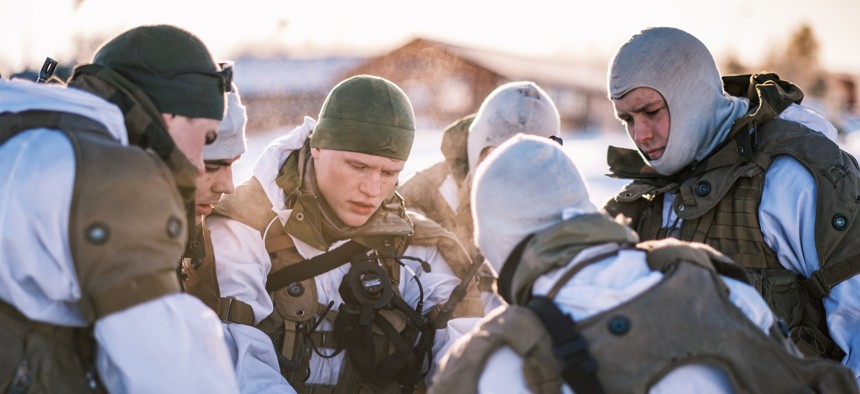
Norwegian troops exercise in the far northern region of Norway in early March 2021. Ole-Sverre Haugli/Norwegian Armed Forces
How Norway Is Folding Civilians into National Defense
Not even the U.S. military can be everywhere, so whole-of-society defense is gaining in importance.
Even if you’ve never heard of the region of Finnmark, you know it’s important: it’s the part of Norway that borders Russia. Norway’s armed forces are exercising there this week — and not just its professional armed forces but conscripts and civilians as well. The exercise, which focuses on the defense of local infrastructure, demonstrates an ever-more-important reality: everyone has a role to play in keeping their country safe.
“The exercise is an important part of strengthening our capacity in general, but Finnmark is also a crucial part of Norway with vital infrastructure,” Maj. Gen. Lars Lervik, the Chief of the Norwegian Army, told me one day into the exercise. “The other aspect is speed. We’re exercising a rapidly evolving situation where we have to react extremely quickly.”
The Norwegian government is rebuilding its forces in Finnmark after scrapping the army units based there in the 1990s and early 2000s. The region is home to sensitive installations including Banak Air Base in the town of Lakselv, from which the Norwegian Air Force conducts, among other things, search-and-rescue operations in Finnmark, the Svalbard islands, and other parts of the Arctic. In 2017, the government reinstated territorial defense of the area, and last year the Norwegian Army launched Porsanger Battalion, which like most Norwegian military units includes both active-duty personnel and conscripts.
Banak Air Base, unsurprisingly, played a role this week’s exercise – and offered another opportunity for 19-year-old Even Gaarder to hone his skills as a conscripted soldier in a mortar platoon. And in Norway, “conscripted” means “having successfully passed the highly competitive selection for national service.” Only about 15 percent of Norwegian 19-year-olds are accepted. In the armed forces of yesteryear, conscripts were often a burden, especially because some of them didn’t want to be there and others were ill-suited for their tasks. Not so in Norway’s selective system. “The conscripts are a decisive resource for us, an operative asset,” Lervik said. Gaarder prepared for the assessment tests through mental and physical training – and to his delight he didn’t just pass but was selected for the new Porsanger Battalion.
During this week’s exercise, Gaarder helped other conscripts and active-duty personnel to secure Banak Air Base. “We were having breakfast when the alarm went off and we had to pack everything up,” he recounted. “We were told that the enemy had been localized in Lakselv and were told to secure Banak to prevent the enemy from bringing in forces by air.” Elsewhere in Finnmark, other conscripts and active-duty forces and ultimately commanded by General Lervik himself, exercised securing other key infrastructure.
The exercise demonstrates Norway’s renewed commitment to defending this vast region, whose towns include Lakselv on the coast of Barents Sea, Kirkenes near the Russian border, and lots of hamlets in between. But not even with Porsanger Battalion in place can the Norwegian armed forces cover every part of Finnmark all the time. Nor would the U.S. Marine Corps be of much help in a fast-moving crisis: its impressive collection of pre-positioned equipment is housed in Trondheim in the south of Norway, 20 hours’ drive from Lakselv.
That makes civilians a vital resource. In this week’s exercise, the Army worked with the Home Guard – which in Norway is a separate branch of the armed forces — and with local authorities as well. “Exercising with the Home Guard and civilian authorities is incredibly important,” Lervik told me. “During the exercise we’ve practiced exactly such situations where cooperation has to happen smoothly and rapidly, including notifying the civilian authorities and the Home Guard.” In Norway, national service graduates who joint choose active duty join the Home Guard in their home region, which guarantees the armed forces a steady supply of young, well-prepared citizens who can keep a trained eye and ear on their surroundings and, of course, be called up in case of a contingency. Such contingencies can range from snowstorms to, yes, invasions.
This, in fact, is the sticking point of most national security challenges today: no country’s military, not even the mighty U.S. armed forces, can be everywhere, all the time. With exercises like this week’s rendition in Finnmark, armed forces can teach locals, whether they’ve had military training or not, to be that resource, to notice if something is amiss in their surroundings and know what to do in case of a serious crisis. In 1981, the intruding Soviet submarine in Sweden’s Whiskey on the Rocks incident was first spotted not by the Swedish Navy but by a member of the public.
Gaarder will soon complete his year of national service. It has been hard work, he told me, heavy duties and taxing. But: “It’s a fantastic experience being able to have this amount of responsibility, to be given the right to carry weapons to defend not just myself but others too.”

Norwegian troops exercise in the far northern region of Norway in early March 2021. Ole-Sverre Haugli/Norwegian Armed Forces

Even Gaarder, 19, is a conscripted soldier in a Norwegian mortar platoon. Ole-Sverre Haugli/Norwegian Armed Forces

Maj. Gen. Lars Lervik, the Chief of the Norwegian Army, talks with two soldiers. Ole-Sverre Haugli/Norwegian Armed Forces
NEXT STORY: Shoring Up The Metals Supply Chain




